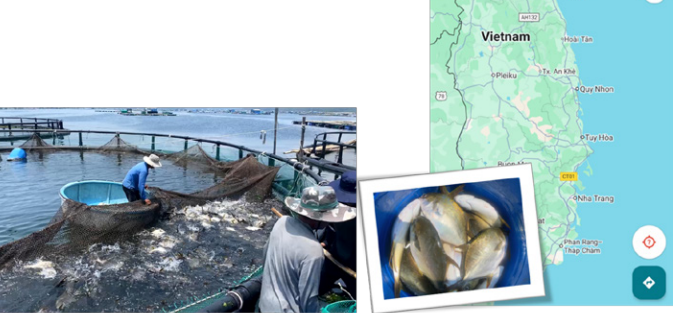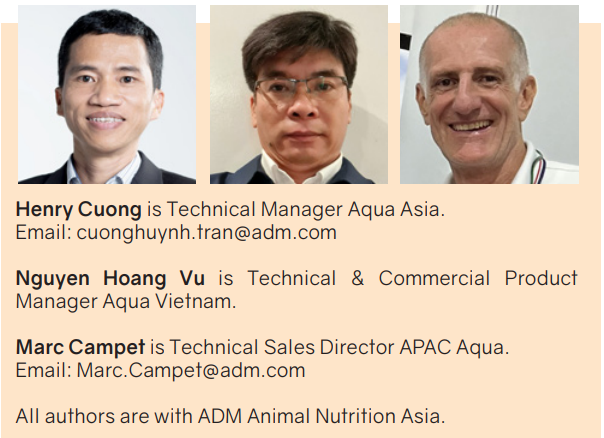With fingerling supply from local hatcheries, next is embracing feed innovations for sustainable growth.

Over the past few decades, Vietnam’s marine fish farming industry has experienced several ups and
downs. Due to efforts and perseverance, farming for several main species has been established – most
notably for grouper (various species), Asian sea bass (barramundi), and cobia – yielding a total marine fish production of 46,000 tonnes in 2023, according to the Directorate of Fisheries, Vietnam.
Despite its vast potential, mariculture in Vietnam is still lagging inland aquaculture due to several significant challenges. The sector is primarily composed of smallscale, family-run farms with limited capital, operating in sheltered coastal bays. Initially reliant on wildcaught seed sources, mariculture has since shifted to importing seedstocks from neighbouring countries such as Taiwan, China, and Indonesia. With the transfer of breeding technology from research institutions, there is now domestic seed supply from local hatcheries.
Feed has also transitioned from homemade to commercial pellets, except for some carnivorous fish which depend partly on trash fish such as cobia and certain species of grouper. Annual tropical storms from September to November in Central Vietnam often cause substantial losses. Moreover, as marine fish are often high-value species, they are primarily exported live to specialised markets such as Hong Kong and China. Domestic demandis often tied to tourism and festive seasons and prices can fluctuate rapidly when there are changes in consumer spending.
Yellowfin pompano: A breakout species
In the past two years, yellowfin pompano including short-fin species (Trachinotus falcatus), long-fin species (Trachinotus blochii) or their hybrids, have rapidly emerged as key species in mariculture, with an estimated production reaching 18,000 tonnes in 2024 (ADM teampers. comm.), ranking second only to the Asian sea bass. Yellowfin pompano farming has benefitted from years of accumulated experience in marine fish culture in Vietnam. In this article, we unravel factors contributing to its impressive growth.
Fingerlings
These are now entirely supplied by domestic hatcheries, in sufficient quantity and quality. Short-fin pompano is usually stocked during the main season (March–June), while long-fin variants are used in the second season (July–October). This species readily accepts commercial feed, with only a small number of farms still relying on trash fish, mainly when prices are low or by-products are available from processing companies. Compared to grouper and cobia, pompano has lower nutritional requirements and can be fed either sinking or floating pellets, depending on the farm’s location, management
style, and farmer preference.
Cage farming
Yellowfin pompano is ideally suited for cage farming in sheltered coastal bays, especially in Central
Vietnam, where water quality is excellent. Recently, the government has officially zoned marine farming to balance the interests of various sectors and promote sustainable development.
Moderately priced fish
The fish is reasonably priced, versatile in preparation, suitable for daily consumption at home as well as
restaurants with table sizes from 500-700g per fish. Compared to high-value species like grouper,
barramundi and cobia, yellowfin pompano enjoys a more stable domestic market (Figure 1).
Strategic solutions for organic growth
To ensure sustainable development and future breakthroughs in yellowfin pompano farming, it is necessary to address a number of challenges with strategic solutions:
Expanding consumption market
To boost domestic consumption, it should be promoted through industry events and media campaigns, including cooking competitions. At the same time, if seafood processing factories can secure export contracts, the industry will gain stronger momentum for growth.


Improving fingerling quality
Successful breeding was first achieved in 2006. and the technology was transferred to local hatcheries. Presently, the fingerling supply chain is divided into two stages: broodstock conditioning for egg production, and nursery operations to supply 4–5cm fingerlings. Overall, it is crucial to develop fast-growing and disease-free fingerlings.
Optimising cage management
Inshore cage systems in sheltered bays are vulnerable to algal blooms during hot weather, and low oxygen levels during floods, when rainwater runoff affects coastal water quality. Therefore, cage placement, stocking time and stocking density are critical to minimise risks.
Recently, farmers have shifted from traditional wooden rectangular cages to more durable plastic round cages, which are both environmentally friendly (avoiding deforestation) and better able to withstand rough sea conditions.
Preventing diseases proactively
Fish health is highly dependent on environmental quality and influenced by local pollution levels and yearly weather patterns. Local authorities should monitor and issue warnings on stocking density, climate changes, and disease outbreaks. Farmers must adopt quarantine protocols for new fingerlings before transferring them to grow-out areas, and proactively prevent parasitic infections that can lead to bacterial outbreaks.
Using suitable commercial feed
Currently, it is estimated that farmers use about 60% slow-sinking and 40% floating pellets of different sizes (2, 3, 4, 5, 6, 7, 8.5, 10, 13 mm) suitable for fish mouth sizes at different farming stages. In addition to promoting fast growth and optimal fish health, pigments are often added to feeds to give the fish a desirable yellow colour for the domestic market (see Table 1).
Perspective
After a “hot growth” period, yellowfin pompano farming, like other species, will enter a phase of consolidation. Farming may decrease like cobia, level off like grouper, or increase like Asian sea bass. Its future hinges on collaboration and innovation to address current challenges and ensure sustainability.
ADM Animal Nutrition is strategically expanding its presence in the marine fish feed sector, with a strong focus on high-performance solutions. One of the flagship products in the Vietnamese market is NUTRILIS POMPANO — a trusted name among aquaculture professionals. Key benefits include:
• Enhanced growth performance;
• Improved fish health;
• Superior body colouration.
With proven results and consistent quality, it continues to support farmers in achieving optimal yields and premium-quality harvests.





